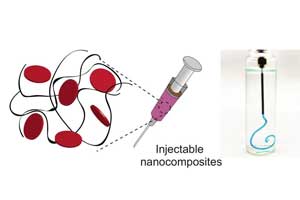- Home
- Editorial
- News
- Practice Guidelines
- Anesthesiology Guidelines
- Cancer Guidelines
- Cardiac Sciences Guidelines
- Critical Care Guidelines
- Dentistry Guidelines
- Dermatology Guidelines
- Diabetes and Endo Guidelines
- Diagnostics Guidelines
- ENT Guidelines
- Featured Practice Guidelines
- Gastroenterology Guidelines
- Geriatrics Guidelines
- Medicine Guidelines
- Nephrology Guidelines
- Neurosciences Guidelines
- Obs and Gynae Guidelines
- Ophthalmology Guidelines
- Orthopaedics Guidelines
- Paediatrics Guidelines
- Psychiatry Guidelines
- Pulmonology Guidelines
- Radiology Guidelines
- Surgery Guidelines
- Urology Guidelines
Injectable bandage THAT stops bleeding

A penetrating injury causing battlefield wounds can ultimately lead to death due to hemorrhaging.Therefore there is an unmet need to quickly self-administer materials that prevent fatality due to excessive blood loss.Dr. Akhilesh K. Gaharwar, in the Department of Biomedical Engineering at Texas A&M University and associates, has published an article "Nanoengineered Injectable Hydrogels for Wound Healing Application" in Acta Biomaterialia in which he has described a kappa-carrageenan and nanosilicates which form injectable hydrogels to promote hemostasis.The researchers have successfully fabricated an injectable bandage to stop bleeding and promote wound healing with a gelling agent commonly used in preparing pastries.
This injectable hydrogel promotes hemostasis (the process to stop bleeding) and facilitates wound healing via a controlled release of therapeutics."Injectable hydrogels are promising materials for achieving hemostasis in case of internal injuries and bleeding, as these biomaterials can be introduced into a wound site using minimally invasive approaches," said Gaharwar. "An ideal injectable bandage should solidify after injection in the wound area and promote a natural clotting cascade. In addition, the injectable bandage should initiate wound healing response after achieving hemostasis."
The study uses a commonly used thickening agent known as kappa-carrageenan, obtained from seaweed, to design injectable hydrogels. Hydrogels are a 3-D water-swollen polymer network, similar to Jell-O, simulating the structure of human tissues.
When kappa-carrageenan is mixed with clay-based nanoparticles, injectable gelatin is obtained. The charged characteristics of clay-based nanoparticles provide a hemostatic ability to the hydrogels. Specifically, plasma protein and platelets from blood adsorption on the gel surface and trigger a blood clotting cascade.
"Interestingly, we also found that these injectable bandages can show a prolonged release of therapeutics that can be used to heal the wound," said Giriraj Lokhande, a graduate student in Gaharwar's lab and first author of the paper. "The negative surface charge of nanoparticles enabled electrostatic interactions with therapeutics thus resulting in the slow release of therapeutics."
For more details click on the link : Acta Biomaterialia, 2018; DOI: 10.1016/j.actbio.2018.01.045

Disclaimer: This site is primarily intended for healthcare professionals. Any content/information on this website does not replace the advice of medical and/or health professionals and should not be construed as medical/diagnostic advice/endorsement or prescription. Use of this site is subject to our terms of use, privacy policy, advertisement policy. © 2020 Minerva Medical Treatment Pvt Ltd